In today’s digital world, SaaS companies are becoming more popular. They provide fresh and innovative solutions for both businesses and individuals. With so many SaaS companies out there, it’s crucial to use effective marketing strategies to stand out. To truly excel in this competitive space, it's important to continuously enhance your skills, which is why many professionals choose to learn marketing courses specifically tailored to the SaaS industry.
This blog post will explore 12 powerful methods for marketing a SaaS company. These strategies will help you connect with your target audience, drive growth, and build a strong brand.
Marketing SaaS is different from other types of marketing. It involves understanding the software industry, knowing what customers need, and staying updated with the latest digital trends.
Using the proper marketing channels and tactics, SaaS companies can clearly show their value, connect with potential customers, and build lasting relationships.
Let’s dive in!
What is SaaS Marketing?
Software as a Service (SaaS) is a cloud-based software delivery model in which applications are hosted and managed by a vendor and made available to customers over the Internet, typically on a subscription basis.
SaaS businesses offer software solutions that users can access and use through a web browser or a mobile app without complex installation or maintenance on their local devices.
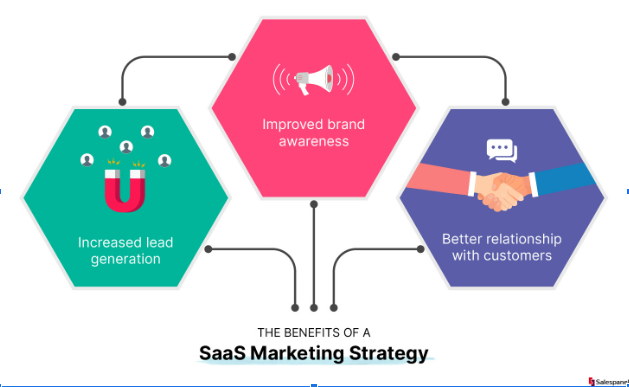
The SaaS business model is based on recurring revenue streams. Customers pay a monthly or annual subscription fee to access the software and its features.
This model differs from traditional software licensing, where customers pay a one-time fee to purchase and own the software.
Marketing a SaaS product, such as a social media scheduling tool, comes with its own set of challenges.
Unlike traditional software, which focuses on driving one-time sales, SaaS marketing requires a continuous effort to attract new customers and retain existing ones.
Some key challenges in SaaS marketing include:
- Demonstrating Value: SaaS products are intangible, so it is crucial to communicate the value proposition and benefits clearly to potential customers.
- Building Trust: Building customer trust is essential since SaaS products involve recurring payments and data storage in the cloud. SaaS companies need to address security concerns and demonstrate reliability.
- Customer Acquisition and Retention: Getting new customers is essential, but keeping the ones you have is just as vital. To reduce customer loss, SaaS businesses should offer excellent customer support, regular product updates, and extra features that add value.
- Scalability: As SaaS businesses grow, they must ensure their infrastructure and resources can scale efficiently to accommodate increasing users without compromising performance or user experience.
- Competitive Landscape: The SaaS market is highly competitive, with numerous players offering similar solutions. SaaS companies must differentiate their offerings, stay innovative, and adapt to changing market demands.
Effective SaaS marketing requires a strategic approach that addresses these challenges and leverages various channels to reach and engage potential customers throughout their buyer's journey.
15 Best SaaS Marketing Strategies
1. Develop a Comprehensive Content Marketing Strategy
Content marketing is a powerful tool for SaaS companies. It helps them become experts in their field and draws in visitors from search engines.
By creating valuable and educational content about your SaaS product, including social media scheduling tools, you can solve your audience's problems. This approach builds trust and establishes your brand as a leader in your area.
One key aspect of a successful content marketing strategy is understanding the types of content that resonate with your audience.
Blog posts, whitepapers, case studies, and videos are all practical formats that can help you achieve different goals. For instance, blog posts can educate your audience on industry trends and best practices, while case studies can showcase your product's success stories.
Tools like a Facebook reel downloader can also help you gather and share engaging video content, further enhancing your content strategy.
Using content to build authority and attract visitors is a long-term effort, but it pays off immensely. So, if you regularly create high-quality and relevant content, you can boost your search engine rankings.
As a result, this will bring more visitors to your website and help you get more leads and sales. Also, creating shareable and engaging content builds a loyal audience and a strong brand community.
2. Optimize Your Website for Search Engines
Optimizing your website for search engines is crucial for driving organic traffic and improving your online visibility. This involves implementing both on-page and off-page SEO strategies.
On-page SEO focuses on optimizing your website's content and structure. Keyword research is the foundation of on-page optimization, as it helps you identify the terms and phrases your target audience is searching for.
Once you've identified relevant keywords, incorporate them strategically into your website's content, meta tags, and header tags. This helps search engines understand the relevance and context of your pages. You can also use React to build a fast, responsive website.
On the other hand, off-page SEO involves building authority and credibility for your website through external signals. Link building is a crucial off-page SEO strategy that involves acquiring high-quality backlinks from reputable websites.
Guest blogging is another practical approach, where you contribute content to other relevant websites and include a link to your site.
Besides SEO, it is very important to ensure that your website is mobile-friendly and loads quickly. More people are using mobile devices to go online, so having a design that adjusts to different screen sizes is essential.
Furthermore, a fast-loading website improves the user experience and can positively impact search engine rankings.
3. Leverage Social Media Platforms
Social media platforms are now crucial for modern marketing. They provide a direct way to connect with your target audience.
To use social media effectively, first, find out which platforms your potential customers use the most. Research their online habits and preferences, then focus on the platforms that match your target audience.
Once you know which social media channels to use, set up a content calendar and stick to a regular posting schedule.
Being consistent helps build brand recognition and keeps your audience engaged. Plan your content ahead of time, mixing educational, entertaining, and promotional posts that your audience will like.
Engagement is critical to social media success. Join conversations, reply to comments and messages, and build a community around your brand. Run contests, ask for feedback, and share user-submitted photos or stories to boost interaction.
This approach strengthens your connection with your audience, provides social proof, and increases brand loyalty. Additionally, embed Instagram on a website to showcase real-time content and further engage visitors with your brand’s social media activity.
4. Implement Email Marketing Campaigns
Email marketing is still one of the best ways to nurture leads and boost conversions. So, building a solid email list is essential.
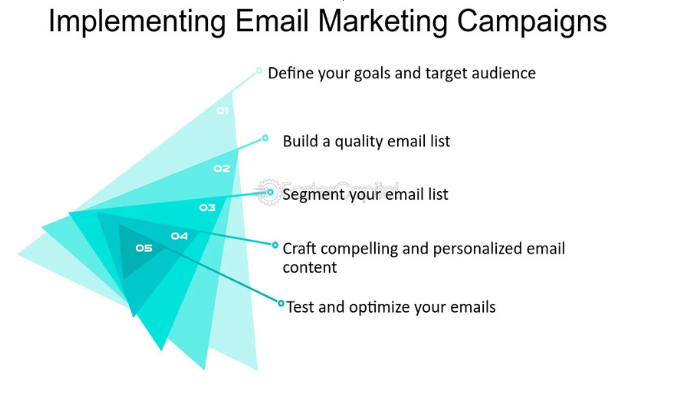
You can build your email list using a LinkedIn email finder to find the correct ones and information about the company.
When creating email campaigns, write catchy subject lines and engaging content that appeals to your target audience. Personalize your emails, highlight what’s great about your SaaS product, and include clear calls to action to guide recipients toward action.
Automating drip campaigns makes lead nurturing more effective. These automated emails send relevant information based on where leads are in their buying journey.
They can help educate potential customers about your product, answer common questions, and motivate them to schedule a demo or purchase.
5. Invest in Pay-Per-Click (PPC) Advertising
Pay-per-click (PPC) advertising is a powerful tool for SaaS companies to connect with their target audience and boost conversions. By bidding on relevant keywords and setting up targeted ads, you can ensure that your product shows up for users who are actively searching for solutions like yours.
A significant benefit of PPC advertising is the ability to target specific keywords and audiences. Keyword research helps you find the terms your potential customers use when looking for products or services like yours.
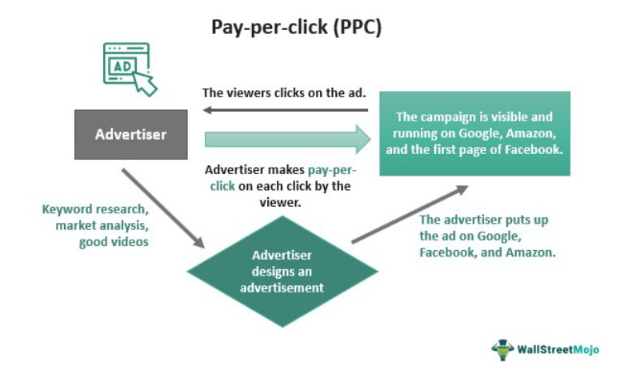
Targeting these keywords in your ads increases the chance of reaching users who are already interested in your services or products.
PPC platforms like Google Ads and Microsoft Advertising allow you to target your audience by location, age, interests, and behaviors. This detailed targeting ensures your ads reach the most relevant people, making advertising spending more efficient.
So, what makes a PPC campaign successful? It’s all about crafting compelling ad copy and designing good landing pages.
Your ad copy should grab attention and highlight what makes your SaaS product unique, encouraging users to click on your ad. Your landing pages should be designed to convert visitors with clear calls to action, persuasive messaging, and a user-friendly layout.
To get the best return on your PPC campaigns, you must keep an eye on and improve them. Regularly review your campaign data, including click-through rates, conversion rates, and cost-per-acquisition.
You can also use this data to adjust your targeting, ad copy, landing pages, and bidding strategies to make your campaigns more effective and get the most out of your advertising budget.
6. Utilize Retargeting Strategies
Retargeting is an innovative marketing tool. It helps you reach out to people who visited your website but didn’t buy anything.
So, if you monitor their online behavior and display ads on other sites just for them, you can ensure that they remember your brand and increase the likelihood of purchasing.
An excellent retargeting method is to create ads based on what users do on your site. For instance, if someone looks at your pricing page but doesn’t sign up, you can show ads that highlight the best features of your product or offer a special discount.
This focused approach, with the help of real-time programmatic advertising experts, makes your ads more appealing and encourages people to take action.
Retargeting can also help make your brand more memorable. Even if a visitor doesn’t buy immediately, seeing your ads repeatedly on various sites helps reinforce your brand’s image. This increased visibility can improve brand recall and lead to more sales later.
To get the most out of retargeting, you should split your audience into groups and tailor your ads for each group. Look at their online behavior, like which pages they visited or if they left items in their cart, and create specific ad campaigns for each group. This way, your ads will be more relevant and have a better chance of leading to sales.
7. Partner with Influencers and Industry Experts
Partnering with famous people or experts in your field can help SaaS companies reach new audiences and build trust. These influencers already have a large following, so using their authority to endorse your product can be very effective.
But, identifying relevant influencers is the first step. Look for individuals who have a strong presence on social media platforms, maintain a popular blog or podcast, or are recognized as thought leaders in your industry. Then, analyze their content, engagement levels, and audience demographics to ensure they align with your target market.
Once you've identified potential influencers, explore opportunities for collaboration. This could involve co-creating content, such as guest blog posts, podcasts, or webinars, where you can showcase your expertise and provide value to your audience.
You can invite influencers to review your product, share their experiences, or even become brand ambassadors.
Another effective strategy is to leverage influencers for product promotions.
This could involve offering exclusive discounts, early access to new features for their followers, or even co-branding a limited-edition version of your product.
When working with influencers, setting clear expectations, guidelines, and compensation agreements is vital. The partnership should feel genuine and transparent because audiences can easily tell when content is not authentic or too focused on selling.
8. Host Webinars and Live Demos
Hosting webinars and live product demos is a powerful way to showcase your SaaS product's features and benefits to potential customers.
These interactive sessions allow you to walk attendees through your software's capabilities, highlighting its unique selling points and addressing common pain points in your industry.
During a webinar or live demo, you can engage with your audience in real-time, answering their questions and addressing any objections they may have. This level of engagement not only helps build trust and credibility but also provides valuable insights into the concerns and needs of your target market.
One significant benefit of webinars and live demos is that they offer a hands-on experience without attendees needing to install or buy your product. Showing them how your solution works and how it can simplify their tasks or solve their issues helps move them closer to making a purchase.
Additionally, webinars and live demos can be recorded and repurposed as on-demand content. This extends their accessibility, ensuring that even those unable to participate initially can still gain valuable insights.
9. Implement a Referral Program
Creating a referral program is a solid strategy to use your current customers and benefit from word-of-mouth marketing.
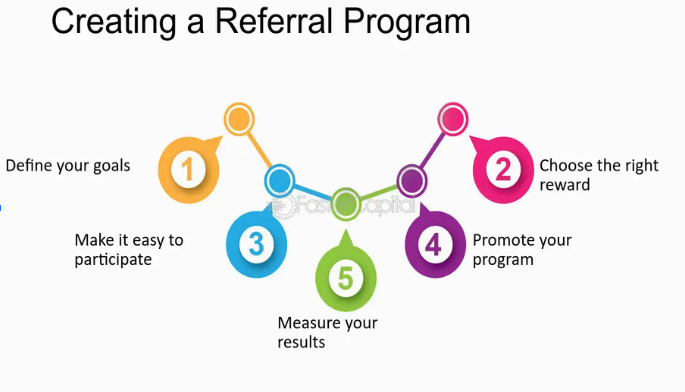
When you encourage your existing customers to recommend your SaaS product to their friends, coworkers, or contacts, you can significantly increase your audience and acquire new customers at a reduced expense.
The key to a successful referral program is offering attractive incentives that motivate customers to become brand advocates. This could include discounts on their subscription, credits towards additional features or services, or even cash rewards.
The more valuable and appealing the incentive, the more likely your customers will be to participate and actively promote your product.
Moreover, referral programs create a sense of trust and social proof.
When a recommendation comes from a trusted source, such as a friend or colleague, potential customers are more likely to consider your product seriously. This word-of-mouth marketing can be incredibly effective in building brand awareness and credibility, especially in the competitive SaaS landscape.
To make your referral program highly effective, ensure simplicity for referrers and their contacts. Give clear instructions, simplify sharing referral links, and streamline the process for redeeming rewards.
Moreover, consider adding game elements like leaderboards, badges, or special acknowledgments for top referrers. This will encourage more participation and foster friendly competition among participants.
10. Participate in Online Communities and Forums
Participating in online communities and forums relevant to your industry can be a potent marketing strategy for SaaS businesses. These platforms provide a unique chance to connect directly with your target audience and showcase your expertise.
It's crucial to pinpoint the most relevant communities and forums. Look for platforms where your potential customers are actively involved, asking questions and seeking solutions. These could include industry-specific forums, Reddit communities, LinkedIn groups, or specialized social media channels.
Once you've pinpointed these platforms, prioritize sharing valuable insights and engaging with community members. Share your expertise, offer expert advice, and join discussions about your product or industry. It's essential to avoid being too promotional or spammy, as this can alienate community members.
You can enhance brand awareness and establish your expertise within your niche by consistently contributing quality content and engaging in meaningful conversations. This will increase the visibility of your SaaS product and cultivate trust and credibility among potential customers.
Moreover, active participation in online communities keeps you informed about industry trends, customer challenges, and emerging technologies.
This valuable insight can guide your product development, refine marketing strategies, and influence overall business decisions.
11. Leverage User-Generated Content
User-generated content (UGC) is a powerful marketing tool that can significantly enhance the credibility and trustworthiness of your SaaS product.
To leverage UGC effectively, actively encourage customers to share their stories and feedback through email campaigns, social media posts, or in-app prompts. In return, you can offer incentives or rewards to motivate them further to participate.
After gathering user-generated content (UGC), feature it prominently on your website and social media profiles. Design specific sections for customer testimonials, reviews, and success stories.
Highlighting user-generated content enhances trust and credibility and serves as powerful social proof. Potential customers are more inclined to trust the experiences and opinions of real users over traditional marketing materials.
12. Offer Free Trials and Freemium Plans
Free trials are an excellent way to demonstrate your product's value and give users a hands-on experience. Trials usually last 7 to 30 days and give users full access to all features of your product. This timeframe enables users to thoroughly evaluate how well your solution can meet their specific needs and address their challenges.
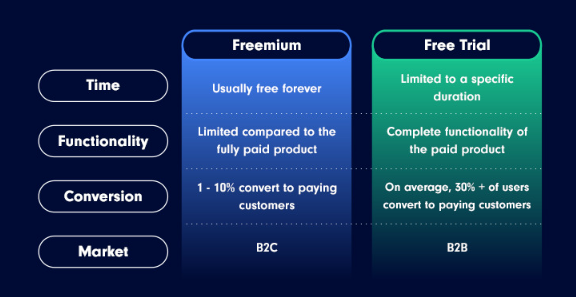
On the other hand, freemium plans provide a free version of your product with restricted features or usage. This strategy is effective for SaaS products that offer extensive features or scalability options.
It allows users to familiarize themselves with your product and explore its fundamental capabilities. They may upgrade to a paid plan for added features or increased usage limits as their needs expand.
Free trials and freemium plans help convert users. They remove the first cost, making it easier for people to try out your product. This approach boosts users' chances to sign up and use your product.
During the trial or free usage period, you can help these users with targeted email campaigns, in-app messages, and personalized support. These efforts will eventually lead users to become paying customers.
In addition, free trials and freemium plans can encourage word-of-mouth marketing and social proof. Happy users often share their positive experiences with others. This sharing helps increase awareness and interest in your product.
It’s crucial to balance your free offering with enough value to draw in users. Meanwhile, keep some appealing features for your paid plans. Review user behavior and conversion rates regularly to refine your free trial or freemium strategy.
SaaS Product Marketing: FAQs
1. How is product marketing different for SaaS companies?
Ans: Product marketing for SaaS companies focuses on digital channels, subscription models, and customer retention strategies. Emphasis is placed on demonstrating value through trials, demos, and content marketing.
2. What is the best way to market a new SaaS product?
Ans: The best way to market a new SaaS product includes content marketing, SEO, social media, email campaigns, and offering free trials or demos. Leveraging customer testimonials and case studies can also be highly effective.
3. Are you looking to hyperscale and validate your SaaS SEO channel?
Yes, if you want to hyperscale and validate your SaaS SEO channel, you should focus on creating high-quality content, optimizing for relevant keywords, building backlinks, and continuously measuring and adjusting your strategies based on performance data.

Wrap Up
Marketing a SaaS company effectively requires a mix of creativity, strategy, and data-driven insights.
Whether using content marketing, SEO, social media, or influencer partnerships, each approach offers unique benefits. Understanding your audience, providing value, and continuously refining your tactics are essential for success.
By applying these 15 strategies, you’ll be well on your way to attracting new customers and keeping your current ones engaged. Remember to stay agile, keep experimenting, and never stop learning. The SaaS landscape is always evolving, and with the right strategies, your company can survive and thrive.
Ready to take your skills to the next level? Upskill with a Skill Success All Access Pass and unlock thousands of courses designed to help you stay ahead in the competitive SaaS market. Start learning today and give your SaaS company the edge it needs to succeed!
About the Author:
Jyoti Ray, the brain behind WPMyWeb.com, focuses on blogging, affiliate marketing and SEO. He writes and has been featured on JeffBullas, SurveyAnyplace, SearchEngineWatch, and more. To connect directly with Jyoti, check out his profile on LinkedIn.

